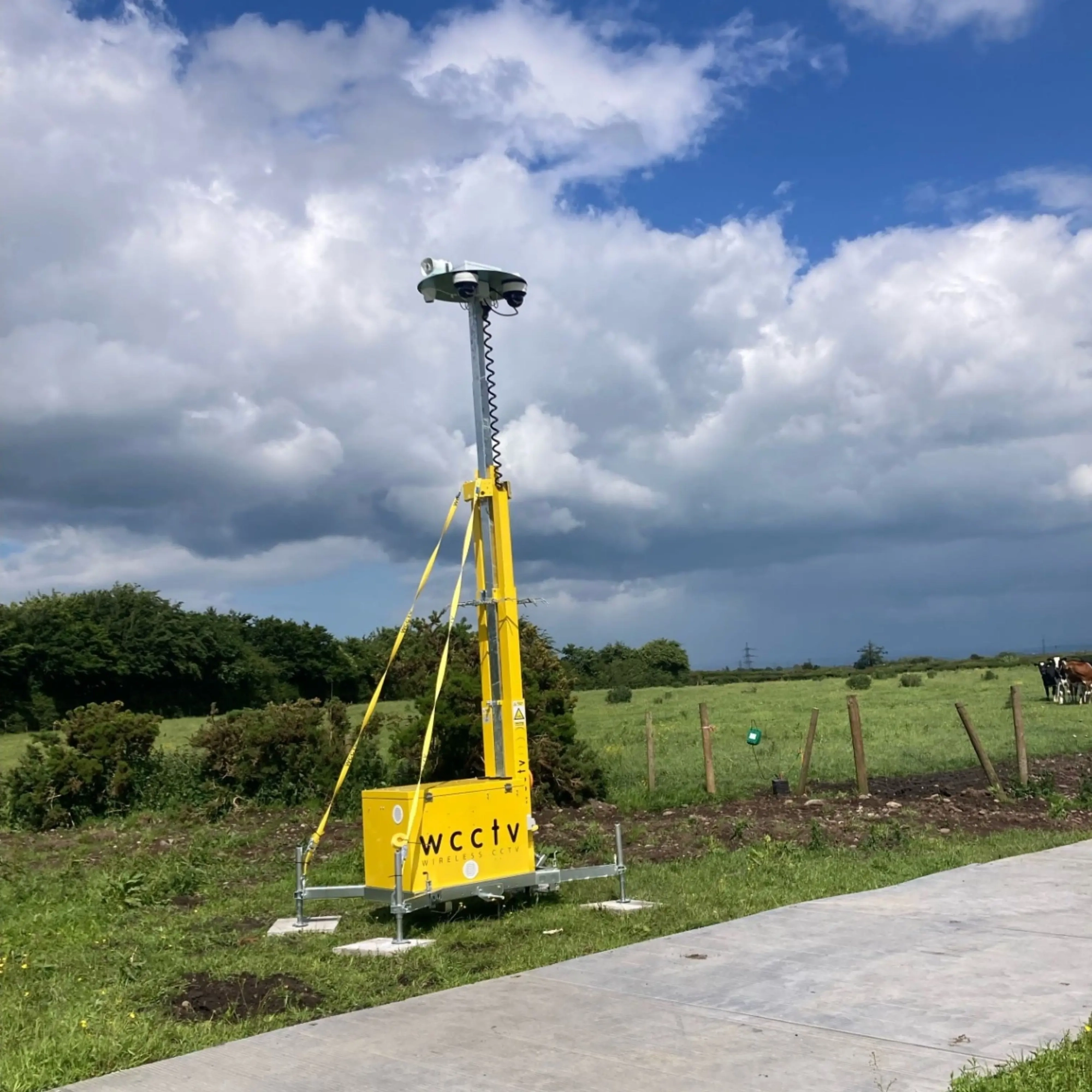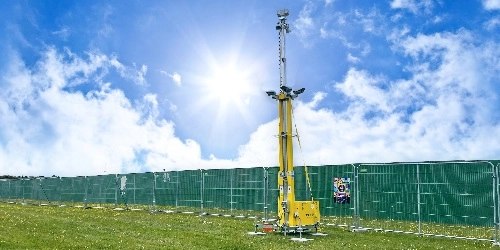The UK's road network is changing and sustainability is leading the way. As councils, transport planners and contractors work toward Net Zero targets, eco-friendly traffic management is becoming a practical solution to cut emissions, reduce congestion and keep roads safe.
In this guide, we'll explain how solar-powered CCTV Towers, fuel-cell technology and smart monitoring systems are the innovative solutions driving Temporary Traffic Management (TTM) operations across the country.
How Sustainable Traffic Management Solutions are Transforming TTM in The UK
The move toward eco-friendly Temporary Traffic Management is all about using smart technology and practical solutions to mitigate environmental impact without compromising safety or efficiency on UK roads.
This is where renewable energy systems and intelligent monitoring are making their mark. The most immediate environmental changes come from phasing out diesel dependency in temporary surveillance and traffic management.
Renewable energy surveillance
Solar and fuel cell battery systems remove reliance on fossil fuels and enable autonomous operation, which is vital for a sustainable future.
-
Solar-powered systems: Solar CCTV Tower systems capture renewable energy from the sun through high-performance panels that charge internal battery units. This enables continuous operation without generators or grid connections, eliminating diesel dependency and Scope 1 emissions.
-
Fuel-cell systems: Fuel cell battery technology uses eco-savvy methanol to generate an electrochemical reaction and produce power. This electricity charges the tower's battery and powers CCTV cameras. The result is lower carbon emissions than diesel generators, plus extended runtime for temporary deployments.
-
Hybrid systems: This is the most effective approach, combining both solar and fuel cell technologies. Solar panels power systems during daylight hours, while fuel cells store excess power to ensure uninterrupted coverage in low light. Our Traffic Management Towers are a hybrid system, running continuously for up to 20 weeks, making them ideal for TTM in all highway locations.
Intelligent monitoring and signage
-
Intelligent Transportation Systems (ITS): Integrate advanced real-time data and communication technologies, such as IoT sensors, GPS and AI, to improve transport network efficiency and sustainability. They help optimise traffic flow, reduce congestion and minimise emissions.
-
AI-video analytics: Modern security systems use intelligent software that distinguishes real risks from false alarms. They automatically identify stopped vehicles, reckless driving, speed limit violations and anti-social behaviour (ASB), enabling faster, more accurate incident responses.
-
Mobile Variable Message Signs (VMSs): Trailer-mounted, full-colour LED boards used to share temporary road information with drivers. Operated remotely via 4G/wireless networks, VMS units display warnings, traffic updates and speed data when combined with radar systems in real-time.
-
Sophisticated radar technology: Specifically designed for TTM, radar systems detect stopped vehicles, pedestrians and congestion as it happens. This real-time insight allows operators to change message signs instantly, signaling lane closures and speed limits to maintain smooth traffic flow.
-
Enhanced Mobile Carriageway Closures (EMCCs): This National Highways-approved TTM technique (a flexible alternative to traditional roadblocks) enables contractors and councils to create traffic-free zones for up to 9 minutes on motorways and high-speed carriageways.
5 Environmental Benefits of Sustainable TTM
Sustainable traffic management solutions have an incredibly positive environmental impact.
1. Reduced carbon emissions and greenhouse gases (GHGs)
Traditional diesel generators produce huge amounts of CO₂ and GHGs during roadworks and maintenance projects. Switching to renewable power sources removes these emissions entirely, helping councils and contractors meet Net Zero commitments.
Solar and fuel-cell systems eliminate the need for diesel generators and reduce vehicle movements to and from a site. This directly cuts Scope 1 emissions from operations and Scope 3 emissions further down the supply chain.
2. Improved air quality
Diesel generators release many pollutants that contribute to air pollution and climate change:
-
Nitrogen oxide (NOx): Formation of smog and acid rain.
-
Carbon monoxide (CO): Toxic gas from incomplete combustion.
-
Particulate matter (PM): Tiny particles that affect respiratory health (e.g., PM1, PM2.5, PM10).
-
Carbon dioxide (CO₂): A key GHG driver of climate change.
By removing diesel-based operations from roadside locations, planners and contractors can reduce nitrogen oxide (NOx) and particulate matter (PM) emissions, resulting in better air quality that aligns with Net Zero goals.
3. Decreased noise pollution
Diesel generators create constant noise that affects workers and nearby residents. Solar and fuel-cell systems operate virtually silently, improving working conditions and reducing "statutory nuisance" complaints around temporary work zones.
Section 61 compliance often requires noise monitoring at highway construction sites. Environmental monitoring sensors track noise in real-time, helping contractors demonstrate compliance long before issues arise.
4. Improved temperature control
Reducing vehicle movements and eliminating heat-generating diesel equipment helps control temperatures in and around urban areas. Less traffic congestion from unnecessary site visits means lower temperatures around roadworks, contributing to a more sustainable future.
Environmental sensors can also monitor temperature and humidity, alongside noise and CO₂ levels, providing tangible data on how innovative solutions improve local conditions.
5. Resource efficiency
In the UK, an estimated 2,000 to 2,500 lane closures take place every week for roadworks and maintenance. To manage this, contractors deploy more than 10 million traffic cones, a process that's both resource-heavy and labour-intensive.
Greener, autonomous TTM systems significantly reduce the need for on-site maintenance and manual interventions. With fewer patrol vehicles and less equipment handling, these sustainable systems cut fuel use and minimise wasted resources across project lifecycles.
By adapting sustainable traffic management solutions, like Traffic Management Towers, transport authorities can move toward a more circular economy, one that uses resources more efficiently, extends equipment lifespans and reduces waste throughout operations.
Read more: The Environmental Benefits of CCTV Towers
WCCTV's Eco‑Friendly Approach to Traffic Management
Our fully-managed Traffic Towers are purpose-built for sustainable highway operations:
-
Autonomous off-grid operation: Running on solar and fuel cell batteries means our Towers operate completely independently of mains electricity or fixed internet. This eliminates Scope 1 emissions from generators and ensures continuous surveillance regardless of fixed infrastructure availability.
-
Rapid deployment and mobility: Standing up to 6 metres tall, our CCTV Towers can be installed within 20 minutes (basic setups). This reduces site preparation time, minimises disruption and allows equipment to move quickly with projects as layouts change. It also reduces the need for maintenance teams associated with onsite visits, further reducing CO₂ and Scope 3 emissions.
-
Weather-resistant design: Weatherproofing equipment maintains reliable operation in harsh weather conditions. Systems continue to protect sites during heavy rains, storms and extreme temperatures without requiring much upkeep or emergency callouts. In-built system diagnostics flag system issues instantly (through the Stellifii platform), with most problems resolved remotely.
-
Smart technology: AI-video analytics distinguish between genuine threats and false alarms caused by weather, passing traffic or debris. This intelligence prevents unnecessary responses, reducing vehicle movements and associated emissions. Additional technologies like ANPR, Body Cameras and Time Lapse Video further strengthen traffic management.
-
Advanced cameras: High-definition PTZ (Pan-Tilt-Zoom) with 40X zoom, infrared (IR) night vision and thermal imagery provide near-360° visibility of traffic networks without requiring operators or councils to visit the site. This means fewer vehicle trips for routine checks, repositioning or response to false alarms.
-
Intelligent integrations: Bolt-on IoT-based environment monitoring sensors track air quality (including PM1, PM2.5 and PM10 emissions), noise levels, humidity, vibrations, CO₂ levels and weather in real-time. This data supports Section 61 compliance and demonstrates due diligence for ESG reporting. All sensor data feeds into our Stellifii platform, where it's automatically compiled for compliance and audit documentation.
-
24/7 remote monitoring: Professional monitoring from NSI Gold Accredited centres means trained security personnel assess camera feeds and threats in real-time. From there, they initiate the appropriate response as required, such as issuing live voice-down audio challenges, dispatching mobile keyholding teams or contacting emergency services. This drastically cuts vehicle emissions, patrol activities and operational costs.
-
Centralised monitoring: In one platform, Stellifii brings together wireless video connectivity, condition monitoring, system diagnostics and reporting that's accessible from any device. The result? Smarter, more responsive systems with less vendor complexity and fewer supply chain activities, helping cut Scope 3 emissions.

Sustainable Traffic Management Starts Here
The shift toward eco-friendly traffic management is already transforming how the UK builds and maintains its roads. By aligning with Net Zero targets, urban planners and contractors can reduce congestion, lower emissions and create safer, greener journeys for all road users.
With 6 regional hubs and over 20-years of experience in wireless monitoring, we know how difficult it can be to implement sustainable TTM that meets both environmental and operational requirements. In terms of affordability, our Traffic Management Towers combine solar, fuel-cell backup and smart automation to provide autonomous surveillance at up to 88% less than the cost of traditional surveillance methods.


